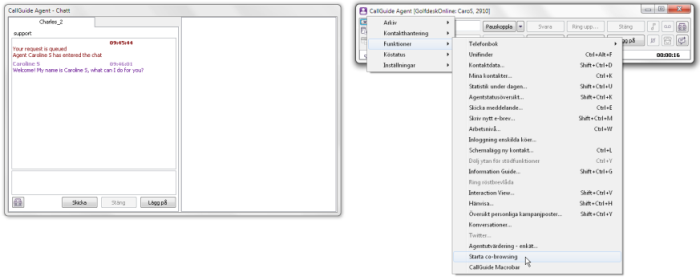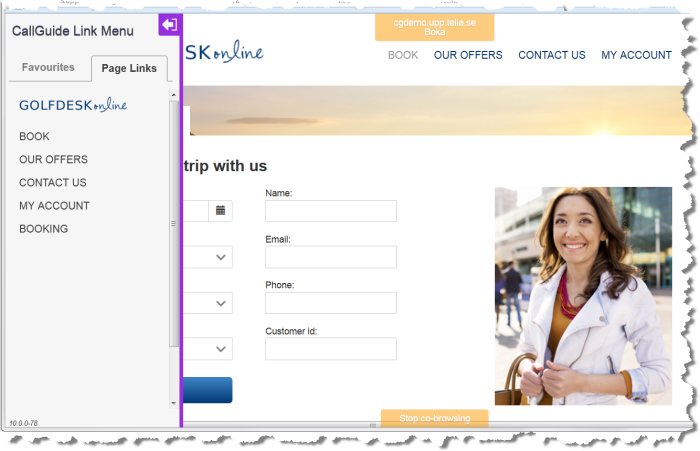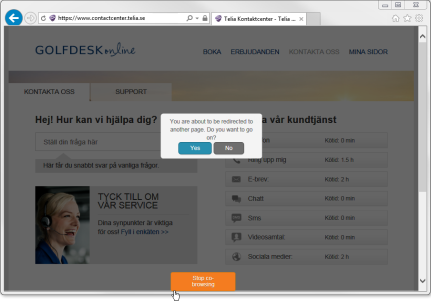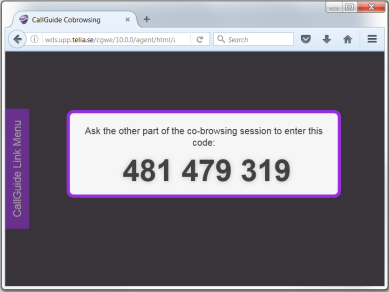 button, or the Functions | Start Co-browsing menu choice.
button, or the Functions | Start Co-browsing menu choice.
Collaborative browsing, or co-browsing, means that two people, in their own respective web browser, jointly look at the same web pages.
If your company has integrated your website with Telia CallGuide, using CallGuide Web SDK and the CallGuide Co-browsing feature, you share web pages with your customer.
In CallGuide Agent you open the web browser with the  button, or the Functions | Start Co-browsing menu choice.
button, or the Functions | Start Co-browsing menu choice.
In Edge Agent you can select the co-browsing option in the Chat card menu
In the web browser you also find CallGuide Link Menu, which you can use to send a web link to navigate the customer's web browser to anther page.
Which contacts you can receive depends e.g. on
When the technical conditions are correct, and if you have the access right to execute co‑browsing, this is how you start using co-browsing in CallGuide Classic Agent:
 During a chat in progress,use the Co-browsing button
During a chat in progress,use the Co-browsing button  at the bottom left in the chat. Co-browsing works in the same way regardless of whether the chat originates from CallGuide Proactive Web or has been initiated by the customer.
at the bottom left in the chat. Co-browsing works in the same way regardless of whether the chat originates from CallGuide Proactive Web or has been initiated by the customer. during a callback call resulting from the proactive web functionality, click on the Co-browsing quick-select button
during a callback call resulting from the proactive web functionality, click on the Co-browsing quick-select button  , if you have configured it to be seen in the main window. This is described in section Select buttons for the most used function. If quick-select button is not available, you can use the Functions| Co-browsing menu choice.
, if you have configured it to be seen in the main window. This is described in section Select buttons for the most used function. If quick-select button is not available, you can use the Functions| Co-browsing menu choice. 





 For other types of contacts you are required to convey a code that the customer shall supply at your web page. The code is created when you start co-browsing as described above.
For other types of contacts you are required to convey a code that the customer shall supply at your web page. The code is created when you start co-browsing as described above.

When CallGuide Co-browsing starts, a web browser is opened. In client settings for Classic Agent, you can choose which browser you want to use for CallGuide Co-browsing.
For a chat initiated by the customer at your website, or a chat or callback call that is the result of a so-called proactive web contact, there is automatically contact data ensuring that the person you are co-browsing with is indeed the person you are for example talking to in your telephone. To co-browse with a customer who has called, sent an email, etc, you first have to share a code, created by the CallGuide Co-browsing start page.
When you, during a contact in progress, start co-browsing, the customer gets an enquiry. The enquiry is normally a dialogue box with text such as Accept co-browsing? and buttons Yes and No. The customer can decline to share his web page, but if he accepts, the following is what you as an agent see in your web browser.

The customer can decline to share his web page, but if he accepts, the following is what you as an agent see in your web browser.
 .
. Normally, the customer cannot see where the agent is clicking.
There might be cases where you can’t see what the customer writes or points at, and when you can't use the pointing or clicking options mentioned above.
When co-browsing is in progress, you can, as an agent, navigate the customer’s web browser by sending a self made or an existinglink, using CallGuide Link Menu.
In CallGuide Classic Agent the web links are added, modified, removed and sent via the Functions | CallGuide Link Menu menu choice. When your co-browsing web browser is open in CallGuide Agent you see CallGuide Link Menu as an pull tab farthest to the left. In Edge Agent you open the CallGuide Link Menu from the chat cards' menus.
To minimize CallGuide Link Menu to be seen as a pull tab, use  to the right. CallGuide Link Menu closes when you close the entire web browser.
to the right. CallGuide Link Menu closes when you close the entire web browser.

The Page Links tab shows all the links available on your web sites.
The Favourites tab is where your self made links are saved.
 .
.  or minimize the fields again with
or minimize the fields again with 
 Click on the arrow to send the link substituting the customer’s web page.
Click on the arrow to send the link substituting the customer’s web page. Open editing mode where you see and can modify the name of the link and its belonging url.
Open editing mode where you see and can modify the name of the link and its belonging url.  Remove a link completely
Remove a link completelyIf the sent web link is outside your own company web site, both you and the customer get a warning that the screen sharing will be discontinued.

If the customer surfs to a web page that is not part of your domains, co-browsing is interrupted and you do no longer see the same view as the customer. However, the contact is resumed automatically if the customer surfs back to the page you shared, provided that co-browsing is still in progress in your computer, meaning that you have not clicked on the Stop co-browsing button or closed your web browser. Should you still want to share web pages, you can, in the chat or callback call in progress, ask the customer to back in his web browser to resume the sharing.
For contacts that are not chat or callbacks started via CallGuide Proactive web, a code is required to be able to co-browse. To be able to share a web page with a customer having for example called, you must first have a code to read to the calling customer, or send it as a text message. This code ensures that you are co-browsing with the correct customer and it can only be used once. In case you e.g. becomes busy it cannot be used towards another agent.

The code is automatically created when you start co-browsing in all situati,ons when you do not have a web initiated chat or callback contact in progress. You just have to inform the customer of the unique number combination. When the other party entered the code and has accepted the co-browsing, the web page sharing is automatically started. When you click OK you will remain on your web page, waiting for co-browsing to start.
Exactly where the customer shall click to type his code is decided when your organisation integrates CallGuide Co-browsing with your web pages. It can, as in this example, be a small icon at the bottom right corner of the your corporate web page.

Co-browsing is possible directly for web initiated chat and callback contacts, or after supplying a code for other contact media. However, there are situations when co-browsing cannot be offered at all. If the customer has a too old web browser, Telia CallGuide detects that and inactivates the function. If you move your mouse pointer over the co‑browsing button in a chat or main window, you can see a help text describing more exactly why co-browsing is not allowed.
Once you have started co-browsing it can continue until you end your contact. In other words, you can keep on sharing a web page with the customer even if the contact is parked, if you make an enquiry, alternates or participates in a conference. If co‑browsing is not ended, it can even be resumed after your having transferred the contact or re-queued it. However, if you or the customer end co-browsing and you then transfer or requeue the contact, you see the co-browsing as finished with that very contact. However, it is always possible to start a new co-browsing with the same customer, with a new code.
Telia CallGuide version 10.0. New info since last release is highlighted. ©Telia Sverige AB